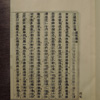續修四庫全書總目提要 (XiuXi SiKu Quanshu Zongmu Tiyao), translated approximately as the Continued Annotated Catalog of the Complete Imperial Library, was compiled between 1931 to 1945 by a group of scholars from the disciplines of Confucian classic study, historiography, philology, bibliography, chorography and chronicles study. This book, which follows the style of the Siku Quanshu compiled during the Qianlong period, is another important large-scale volume containing more than thirty thousand ancient texts.
Due to the constraints and limits of the years and circumstances of its compilation, the 四庫全書總目提要, or Annotated Catalog of the Complete Imperial Library—a text from the late 18th century that had been the authoritative annotated bibliography on Siku Quanshu—has its shortcomings. In addition, from the period between Qianlong and the end of the Qing dynasty, with the increase of study and research given to the Siku Quanshu by Chinese scholars, there began to be a clamor for the creation of a sequel to the Annotated Catalog of the Complete Imperial Library.
The dividing up of China by the Eight-Nation Alliance as a result of the Boxer Rebellion in 1900 resulted in the signing of the Boxer Protocol which entailed an indemnity of what amounted to almost 1 billion taels (more than $US 660 million today). After different rounds of negotiations with the nations involved, the United States of America was the first to return part of the indemnity to China for the construction of cultural activities.
After the initiation of the United States to return part of the indemnity to China for cultural and educational purposes, other countries followed. In 1923, the house of representative in Japan and the parliament passed a law – Japan's Sino cultural policy ("日本對華文化事業特別會計法"). Subsequently China and Japan signed the following agreemnts: Wang-Debuchi Agreement of February 6, 1924 (汪公使與出淵局長瞭解事項覺書) and Yoshizawa-Shen Exchange of Notes of May 4, 1925 (芳澤公使與沈外長換文). Based on these three documents, the fund to create a sequel to the Annotated Catalog of the Complete Imperial Library was established
The Beijing Institute of Humanity was founded in 1927 and headed by Ke Shao Min (柯紹忞). The institute used part of the indemnity allotted to Japan from the Boxer Protocol to fund the Sikuquanshu Sequel project. The framework of the project was to collect the books which are not included in the Sikuquanshu, and also works published during the period of Qianlong to the end of the Qing dynasty.
Starting from 1935, the Beijing Institute of Humanity provided a copy of the draft of the continued annotated bibliography to the Institute of Oriental Culture Studies of Kyoto. After China had already submitted over 10,080 abstracts, Japan started an invasion of China, resulting in the cessation of drafts being provided by Chinese scholars. In 1972, the Commercial Press in Taiwan published a version based on the copies in Japan (and omitting the drafts in the mainland). But since the original drafts and scholars were not available to help verify the information contained therein, lots of mistakes are contained in this publication.
At the end of the Japanese invasion, the original draft and all the related documents were handed over to 沈兼士 and these documents were given to the National Science Library (in Beijing).
The Continued Annotated Catalog of the Complete Imperial Library, from start to finish, had gone through many hurdles—unable to go through a proper publication, and with parts of the drafts dispersed. These two volumes were draft printed during this period are classified as non-canonical (集部).
The first page of the volume has the date of year 27 of march indicates that this copy was done in the 27th year of the Republic Period which is 1938 – this is probably the date where this draft was submitted to the department concerned.
Since the Synopsis to the Sequel has never been published, this type of original draft has very high academic value.
The gathering and dispersing of ancient texts have a close relationship with the social stability of a nation. At the end of the Qing dynasty, the situation in China was unsettling with different invasions—and the loss of cultural relics surpassed the loss in previous dynasties.
"Continued Annotated Catalog of the Complete Imperial Library" is part of the Chinese Cultural Studies Center library collection.
Database of Ancient Chinese Texts series:





